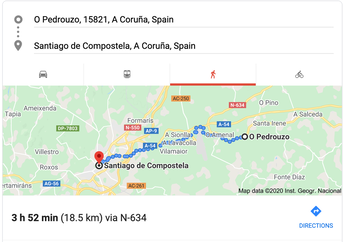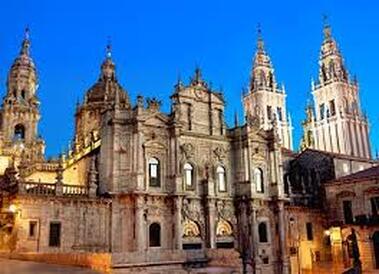 The final stage of the Camino Frances is from O Pedrouzo to Santiago de Compostela. At 19.7km, it’s one of the shortest days on the route; because it’s the last stage, headed toward the place where all the pilgrims are converging, it’s the most crowded part of the walk. For those who started in St. Jean Pied de Port and walked straight through, it’s been a 775km (481 mile) journey. Those who skipped the meseta (that would be my group) were looking at 482km (299 miles). Either way: that’s a hell of a long walk. Santiago de Compostela is the (disputed) site of the tomb of St. James (yep—the apostle James from the New Testament). Since the Middle Ages, pilgrims have been traveling (on foot, mostly) to visit the Catedral de Santiago de Compostela. With its baroque façade and Romanesque bell towers, it’s impressive even if you aren’t Catholic, and even after you’ve passed roughly a hundred churches along the way. Upon arrival, travelers queue outside the pilgrim office to get their official Compostela, the certificate that proves the pilgrimage happened—something that will presumably last longer than blisters and sore muscles. Maybe even longer than a blog post. Buen Camino, the typical greeting of pilgrims on the trail, translates to good road or good path. It’s an acknowledgement of a shared sense of purpose, an understanding and respect for another person’s journey.
The last time I was in Spain (which is a funny way to say it, as if I’m in Spain all the time)—we went to Pamplona and Will did the encierro, the running with the bulls. There’s a traditional costume for the run—a white shirt, white pants, a red scarf around the waist and a red handkerchief around the neck. (The white represents San Fermin’s purity; the red represents his death by decapitation. You don’t have to dig far into tradition to find the blood and gore.) The streets are full of runners in these costumes; the clothing marks them, gives them a sense of camaraderie. After his run, when his head was so inflated he had to duck through the doorways, Will was part of this group. His heart was still pumping overtime, adrenaline not yet settled. Every time we passed another person in white and red, they acknowledged each other with a solemn nod. Solidarity. We survived. ** Santiago is lively: here’s where you meet up with the people you passed along the way, where you get your Camino souvenirs and (ill-advised?) scallop-shell tattoos. There’s a guy playing bagpipes in the cathedral passageway. Many people stay in the Parador, a famed five-star hotel—a definite luxury after bunkbeds and communal living. (“Would we have stayed in the Parador?” I asked Will. He laughed. “I can tell you damn well we wouldn’t be staying in an albergue.”) There’s something celebratory about being in Santiago de Compostela, for sure—but also, something bittersweet. It’s the end of one journey, the beginning of another. ** If the walk changes you, then who are you at the end? What will you do with yourself? How will you take your changed self back to the real world? The truth is, writing this blog has more or less saved me from a deep Camino-shaped depression. Back in March when the pandemic hit and shelter in place became mandatory, I threw all my focus into figuring out remote teaching. I had to rethink some curriculum, learn different ways to deliver information, and stop teaching at times to be a counselor, a cheerleader, a person in my students’ lives who cared. While the Internet was full of witty memes and suggestions about how to spend the time in quarantine—I was swamped, so tired some nights that I dragged myself to bed before ten. And then, abruptly, the semester ended the first week of May. I did my grading. I cleaned the house. I tackled a few neglected projects. I kept moving to keep the weight of the trip I wasn’t going to be taking from settling onto my chest, like an X-ray apron. The summer of doing nothing and seeing just about no one, trapped mostly in my house during long strings of one hundred plus days loomed on the horizon, an unbearable possibility. “I think I might do a little blog about our trip,” I told Will. “What trip?” “The one we’re not taking.” “Huh,” he said. ** I don’t do a lot of personal writing. (Or I do, but it’s disguised as fiction.) My own life has never struck me as particularly interesting—just comfortable—and I worried that I wouldn’t have the material to keep this going. No problem, I thought. I’ll write about our pets. I’ll write about Will. I’ll write about the Camino itself. It’s been like a little puzzle to figure out every day, finding the edges and corners, filling in the middle. It has been its own kind of journey. ** It’s said that the walk changes you, but I think it must also be true that the walk changes everyone in a different way. That’s another mantra of the Camino: no two Caminos are ever the same. Put another way: everyone walks their own Camino.
0 Comments
Leave a Reply. |
Paula Treick DeBoardJust me. Archives
December 2023
Categories |

 RSS Feed
RSS Feed